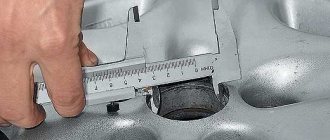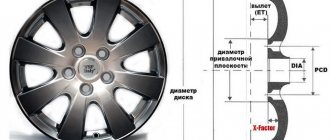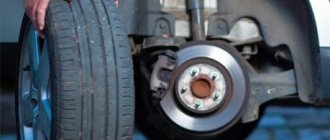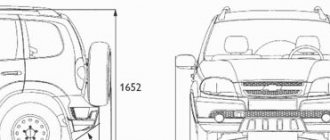Car accessories are also stored in the garage along with the car. Most often these are seasonal tires. Correct storage of tires is responsible for the quality, and subsequently, the safety during operation of the wheels.
Negligent attitude to the issue of storing wheels can lead to deformation of the shape and damage to the material of the tires. It is more practical to store car tires in a place equipped with a rack. Let's figure out how to make a rack for storing car tires with your own hands.
In the photo: an option for storing wheels in the garage from GarageTek
Before starting work, you need to decide on the place where the wheel rack will be located in the garage. There are several recommendations for the placement of shelving in the garage.
- It is not allowed to install the rack close to the wall so that the wheels do not come into contact with anything. To do this, you need to leave a gap between the wall and the shelving.
- The rack must not be placed close to the vehicle to avoid damage. Wheels may fall from the upper tiers of the rack, thereby leaving dents on the car.
- It is not permitted to place the rack next to chemicals. If liquids such as gasoline or oil come into contact, they can cause tire deformation.
Next, you should select the material from which the rack will be constructed. It is more advisable to choose wood, since working with wood does not require special skills and wood is cheaper than, for example, metal. To create a metal structure, you will need welding skills and the welding machine itself.
After this, you need to prepare a drawing or diagram with the exact dimensions of the product and the amount of material. The size of the rack will depend on the dimensions of the garage itself and the availability of free space.
In addition, you will need to acquire:
- tools (hacksaw, hammer, tape measure, screwdriver, metal corners),
- materials (boards, bars),
- coatings for wood against rotting and parasites (impregnation, paint, antiseptic).
In the photo: racks for storing rubber from GarageTek
It is optimal to create a two-tier rack for wheels, which will allow you to store tires in a horizontal and vertical position. The horizontal option is suitable for storing wheels with rims, and the vertical option is suitable for storing tires without rims.
For such a rack you will need four bars for the racks. If the product is more than one meter wide, it is recommended to add two more racks on different sides to avoid the rack breaking due to overload. You will also need four long boards for horizontal bracing and boards for cross bracing between posts. Such bars and boards are cut out according to a previously prepared drawing, thanks to which errors in the size and quantity of material will not arise.
If desired, the rack can be equipped with shelves. A shelf under the wheels will allow you to store additional items for the car. Chipboard sheets or regular boards are suitable for flooring, but such a rack will need sides to prevent the wheels from rolling off when stored vertically. You can also leave the rack as a frame. In this case, the tires will be fixed with long boards for horizontal connection.
The racks are installed to long boards for horizontal bracing and boards for transverse bracing using self-tapping screws. To strengthen the structure, the joints between the boards are additionally fixed with metal corners. Such corners will add strength to the product and allow you to store several sets of rubber.
The rack for storing automobile tires can be either mobile or fixed. For mobility of the rack, you will need to attach wheels to the racks. Such a rack requires the installation of an additional spacer along the long side. A diagonal brace will increase the rigidity and strength of the rack.
Wheels for the rack are purchased depending on the load that will be placed on the rack. The heavier the load, the more powerful the wheels attached to the rack should be. These wheels allow you to move the rack throughout the garage and take it outside to your car.
Finally, the wooden rack must be coated with an antiseptic, impregnated, then dried well and painted with moisture-resistant paint. Such a rack in the garage will solve the problem of storing replacement tires for a car and save space.
In the photo: helps with placing car tires on special shelves
The GarageTek team can help with the problem of storing both car tires and other accessories in the garage. "GarageTek" implements a convenient and comfortable storage system in the garage according to any wishes of the owner
Even more useful information:
The onset of winter for a driver means not only a change in weather conditions, but also the need to replace a set of tires on a car for safe movement on public roads. The summer set is put away in the garage until the end of spring and often its storage conditions leave much to be desired. Why improper storage spoils tires and why a rack for wheels is needed in the garage, we will look into it below.
Rules for storing car wheels
Not every car owner knows that they need to follow the rules for storing wheels, otherwise they quickly become unusable and can fail at the most inopportune moment. Different sets of tires have specific storage conditions, but general rules can also be identified, the observance of which will be relevant in any situation:
- Do not store wheels near heating or cooling devices. Significant temperature changes occur near them, which cause condensation to accumulate and deformation of the rubber.
- Make sure that the wheels are not exposed to moisture, oil or acidic liquids.
- Store tires in a cool, dry place.
- If the wheels are wrapped in film, do not forget to periodically remove and ventilate them. Otherwise, dampness will begin to accumulate inside, which will negatively affect the material in the future.
Now let's look at the individual storage features of different sets.
Summer tires
Summer tires are made from materials whose composition is different from winter tires, and accordingly, the storage conditions will be different. The peculiarity of storing summer tires is that the room temperature should be kept around 20 o, with a relative humidity level not exceeding 60%. Small deviations from these indicators are acceptable.
Design features
Diagrams and design drawings for tire maintenance can satisfy any requirements of the car owner. It can be:
- racks and shelves of various configurations;
- hooks and stands;
- specialized cabinets in which you can create your own microclimate, ideal for keeping a particular set of tires in the garage.
Some of them are universal and suitable for any tire, others are highly specialized and designed for special conditions.
Racks and shelves
A rack for storing wheels in a garage gives the owner the following advantages:
- the ability to equip a rack with wheels with additional shelves designed for various tools;
- depending on the size of the garage and the amount of free space, the size and shape of the stand can be easily adjusted during assembly;
- the design has a large margin of safety at a relatively low cost.
Hooks and stands
Convenient devices for storing wheels in the garage, with the following advantages:
- easily and quickly made independently;
- take up little space and can be placed in any free corner of the garage;
- the stand, unlike a shelf or rack, can be easily moved from place to place and, in case of repair, it does not need to be dismantled or disassembled;
- materials for their manufacture are readily available and relatively cheap.
Note! Wheel hooks can be made as permanent brackets that attach to the wall, or as a removable piece that can be hung from a metal cable or rope, which is very convenient.
Specialized cabinets
If there is desire, time and money, the garage owner can equip the room with a special cabinet for storing wheels. Advantages of cabinets:
- the design does not spoil the appearance of the room;
- placed in any free space. It is not necessary to install it on the floor; you can make special fastenings and hang it on the wall;
- storing the wheels in a special cabinet will ensure that a jar of oil or other liquid that is in your garage will not accidentally be knocked over on them. This will significantly extend the life of the tires.
Is it possible to keep rubber in a metal structure?
The fact is that it is necessary to adhere to strict rules for saving tires, which include maintaining a certain temperature, air humidity, etc. A metal garage can get very hot in the summer and it will be very dry inside, which is unacceptable for rubber. If such a structure is located in the shade of trees, then as a last resort you can leave the wheels in it, but only in a suspended state.
Building racks for storing tires with your own hands is not so difficult, the main thing is to think everything through correctly and be patient. And what materials to use to implement an idea is an individual choice for everyone.
Car accessories are also stored in the garage along with the car. Most often these are seasonal tires. Correct storage of tires is responsible for the quality, and subsequently, the safety during operation of the wheels.
Negligent attitude to the issue of storing wheels can lead to deformation of the shape and damage to the material of the tires. It is more practical to store car tires in a place equipped with a rack. Let's figure out how to make a rack for storing car tires with your own hands.
In the photo: an option for storing wheels in the garage from GarageTek
Before starting work, you need to decide on the place where the wheel rack will be located in the garage. There are several recommendations for the placement of shelving in the garage.
- It is not allowed to install the rack close to the wall so that the wheels do not come into contact with anything. To do this, you need to leave a gap between the wall and the shelving.
- The rack must not be placed close to the vehicle to avoid damage. Wheels may fall from the upper tiers of the rack, thereby leaving dents on the car.
- It is not permitted to place the rack next to chemicals. If liquids such as gasoline or oil come into contact, they can cause tire deformation.
Next, you should select the material from which the rack will be constructed. It is more advisable to choose wood, since working with wood does not require special skills and wood is cheaper than, for example, metal. To create a metal structure, you will need welding skills and the welding machine itself.
After this, you need to prepare a drawing or diagram with the exact dimensions of the product and the amount of material. The size of the rack will depend on the dimensions of the garage itself and the availability of free space.
In addition, you will need to acquire:
- tools (hacksaw, hammer, tape measure, screwdriver, metal corners),
- materials (boards, bars),
- coatings for wood against rotting and parasites (impregnation, paint, antiseptic).
In the photo: racks for storing rubber from GarageTek
It is optimal to create a two-tier rack for wheels, which will allow you to store tires in a horizontal and vertical position. The horizontal option is suitable for storing wheels with rims, and the vertical option is suitable for storing tires without rims.
For such a rack you will need four bars for the racks. If the product is more than one meter wide, it is recommended to add two more racks on different sides to avoid the rack breaking due to overload. You will also need four long boards for horizontal bracing and boards for cross bracing between posts. Such bars and boards are cut out according to a previously prepared drawing, thanks to which errors in the size and quantity of material will not arise.
If desired, the rack can be equipped with shelves. A shelf under the wheels will allow you to store additional items for the car. Chipboard sheets or regular boards are suitable for flooring, but such a rack will need sides to prevent the wheels from rolling off when stored vertically. You can also leave the rack as a frame. In this case, the tires will be fixed with long boards for horizontal connection.
The racks are installed to long boards for horizontal bracing and boards for transverse bracing using self-tapping screws. To strengthen the structure, the joints between the boards are additionally fixed with metal corners. Such corners will add strength to the product and allow you to store several sets of rubber.
The rack for storing automobile tires can be either mobile or fixed. For mobility of the rack, you will need to attach wheels to the racks. Such a rack requires the installation of an additional spacer along the long side. A diagonal brace will increase the rigidity and strength of the rack.
Wheels for the rack are purchased depending on the load that will be placed on the rack. The heavier the load, the more powerful the wheels attached to the rack should be. These wheels allow you to move the rack throughout the garage and take it outside to your car.
Finally, the wooden rack must be coated with an antiseptic, impregnated, then dried well and painted with moisture-resistant paint. Such a rack in the garage will solve the problem of storing replacement tires for a car and save space.
In the photo: helps with placing car tires on special shelves
The GarageTek team can help with the problem of storing both car tires and other accessories in the garage. "GarageTek" implements a convenient and comfortable storage system in the garage according to any wishes of the owner
You should store winter tires on rims correctly so that you don’t get upset later about spending extra money on new “shoes” for your car. It is not difficult to make a simple rack for wheels in the garage from wood or metal corners.
For those who don't want to spend time improving their garage, there are other interesting and simple tips for storing tires and tyres.
Making a wooden rack with your own hands
Despite the abundance of different designs or devices, not every vehicle owner has the opportunity to spend money on such purchases. The solution in this situation would be to build a wooden rack in the garage, which will require a minimum of costs and will last no worse than its metal counterpart.
Construction consists of the following stages:
- preparation of tools and materials;
- cutting material according to selected drawings;
- assembly and installation of the structure.
These simple steps will help you store wheels in your garage correctly, without damaging them or cluttering the room.
Preparatory work
Preparatory work before constructing the rack consists of the following steps:
- search for suitable drawings;
- preparing the required amount of materials for their implementation;
- preparation of tools. Among them must be: a hammer, a tape measure, a saw or a hacksaw, a level, a screwdriver or a screwdriver, a corner;
- preparing the site for the construction of the structure. It needs to be cleared of debris and filled with concrete if the floor in the garage is not level;
- It is advisable to treat the wood with chemical compounds that prevent rotting and mold formation.
Cutting material according to drawings
The cutting system depends on the complexity of the selected drawing. The number of steps required for cutting may vary.
The basic sequence of actions is as follows:
- We prepare the racks. For one section, the width of which is 1 meter, 4 racks are required. It is not recommended to build a rack whose width exceeds 1.5 meters. Wooden shelves will not be able to withstand the load and will begin to sag in the center. This will negatively affect both the durability of the structure and the condition of the stored wheels.
- We cut off the bars of the required length, which will act as a connecting element of the rack.
- Cut out the shelves. A 150 x 40 mm board or chipboard is suitable as a material for shelves.
Assembly and fastening of the frame
Assembly and fastening are carried out in accordance with the drawing. When assembling the structure, consider the following nuances:
- Assembling a permanent structure begins with attaching the racks to the rear wall of the garage.
- In some cases, the rear wall of the rack will be reinforced with special spacers.
- Elements of the rack that come into contact with the tires must not have corners or irregularities. Otherwise, they will deform the rubber, and you will have to purchase a new set.
Garage projects
- 23.1² Total area
- 26² Total area
- 6 x 4m Construction area
- 41² Total area
- 6 x 6m Construction area
- 30.17² Total area
- 6 x 11m Construction area
- 31.8² Total area
- 32² Total area
- 22² Total area
- 4 x 6m Building area
- 28² Total area
- 4 x 8m Construction area
- 42² Total area
- 11.7² Total area
- 22² Total area
- 4 x 6m Building area
- 40² Total area
- 8 x 5m Construction area
- 57² Total area
- 24² Total area
- 58² Total area
- 10 x 6m Construction area
- 24² Total area
- 6 x 4m Construction area
- 40.6² Total area
- 2 rooms
- 1 bathroom
- 192.58² Total area
- 31.8² Total area
- 76.2² Total area
This article will be useful for any car enthusiast, because it will talk about proper storage of tires using devices such as a wheel rack in the garage.
This addition is very convenient and practical, in addition, it will protect spare parts from damage and falls. In addition, like other tools and materials, automotive components and assemblies must be placed not on a concrete floor, but on special shelves. After reading the text, you will learn about the conditions under which tires should be stored, what kind of shelves and other accessories there are for wheels in the garage, and how a rack for storing tires is made. Floor-mounted tire storage rack design Source pinterest.com
Types of garage shelving
The simplest solution for arranging a garage is to purchase ready-made factory structures. Most of them are collapsible, but there are also monolithic models. The first are assembled from individual parts using bolted connections.
There are several types of garage racks:
- Stationary. Such structures are designed for a specific location and assembled once and for all. Fixed to the wall and/or floor using metal corners and brackets. This rack has a high load-bearing capacity, it is immovable and safe to use.
- Mobile. The structures are mobile due to wheels installed on the legs. Massive racks of this type are installed on a mobile base in the form of a flat cart and equipped with handles that facilitate transportation.
- Collapsible. When manufacturing independently, the most suitable models of collapsible factory structures are often taken as a basis. They consist of many elements, including shelves, crossbars, and support posts.
- Hanging. Such racks are a complex of shelves and drawers. They are attached to walls or ceilings, so they have restrictions on weight load. Ideal for filling empty spaces on garage walls.
- Console or sliding. Optimal for storing long tools and materials. Equipped with a bottom shelf that extends left or right. They require free space next to them.
- Ceiling. The main elements of these suspended structures are traverses, metal frames, shelves, and anchor bolts.
Racks are differentiated according to their purpose. So, to store wheels, you will need a structure with wide shelves for mounting the wheels flat or narrow ones, but located from each other at the height of the wheel diameter. For storing fasteners and other small items, wall racks with many drawers or containers that can be pulled out or simply mounted on shelves are best suited. For heavy tools and car parts, stationary structures are optimal - reliable and durable.
Garage wheel racks: assembled storage
A convenient simple rack for compact storage of inflated wheels on rims consists of four wide shelves on which the wheels will lie horizontally on top of each other. Such a rack, assembled to the size of rubber from wooden beams and chipboard sheets or boards, can be installed in the far corner of the garage .
To save space, we will complicate the design and install shelves under the desktop or workbench. Here, it is more convenient to place individual shelves for wheels on two floors, in pairs.
However, it is possible to completely exclude the storage of inflated rubber assembly from the lower volume of the garage space. This opportunity is provided by a hanging corner rack mounted on converging walls using durable brackets.
An even more tempting space saver is to hang wheel racks from the ceiling along the wall . This is possible if the design of the garage allows it - it is high enough and covered with reinforced concrete slabs into which the suspension dowels will be screwed.
But with all the advantages of saving space, this design has a big disadvantage. Heavy wheels will be difficult to lift up stairs and remove from hanging shelves. The only consolation is that the need for this inconvenient procedure will arise only twice a year, during seasonal tire changes.
Watch the video on how to easily make a wheel rack in the garage with your own hands:
Corner shelving
Let's take a closer look at the compromise option - a hanging corner rack for storing wheels in the garage made of steel corner and chipboard (fibreboard).
The size of the shelf will be dictated by the diameter and tread width of your wheels.
- Place a sheet of chipboard on the floor in the corner, pressing it tightly against both walls.
- Place the wheel on the sheet, carefully outline it with a pencil or marker. Remove the wheel and find the center of the circle.
- We drive a small nail into the center and attach a cord to it.
- We measure the diameter of the wheel plus 5 cm, attach a marker to the cord and draw a semicircle.
- Using a jigsaw, we cut out a semicircular corner shelf according to the markings.
To create a strong welded frame you will need a steel corner 5x5 cm .
- We weld horizontal corners to the three vertical elements to fit the size of the shelves. We bend the outer semicircular elements according to the template.
This is not difficult if you make cuts in the inner lower side of the corner and gradually bend it until the desired shape is achieved. The cuts can then be welded and polished.
- We cover the manufactured frame with red lead in two or three layers.
- We treat the shelves with drying oil and then paint them.
- We fix the rack at a convenient height. For reliability, we do not use dowels, but drive sharpened pieces of 10-mm steel reinforcement deeper into the wall and weld the shelving frame to them.
- It is advisable to prevent the rubber from coming into contact with the walls. Push the wheel on the shelf until it stops, mark the contact points on the wall. Then remove the wheel, and using small dowels, use small dowels to attach stops made from pieces of thin wooden beams to the wall. Such limiters can also be made from a used tire by cutting out part of the tread in the form of a wide strip.
Materials for production
The most profitable materials for making shelving are metal and wood . They can be combined: the frame can be made of metal, and the shelves and drawers can be made of wood. In this way, the cost of the estimate is reduced without losing the quality of the structure and its strength.
For the manufacture of metal racks use:
- corner 30x50 mm or 40x50 mm;
- profiled pipe with a cross section of 20x50 mm or more;
- round pipes with a diameter of 20-25 mm with a wall thickness of at least 1.5 mm;
- sheet metal with a thickness of 1.5 mm.
Materials are selected depending on the design of the structure. To make wooden parts you will need:
- sheets of moisture-resistant plywood, OSB, MDF, chipboard with a thickness of 1.5 cm;
- bars with a section of 40x40 or 50x50 mm;
- boards with a thickness of at least 25 mm.
The type of wood and its grade are important. Boards with knots cannot be used to make shelves on which you plan to store heavy objects. Resinous wood is problematic to use, since there is always a risk of staining the objects on the shelves with it.
The optimal choice is second grade lumber (“B”), which provides no more than 2 knots per linear meter, a small amount of blue and wane, no more than 2 resin pockets per 1 m of length . Before use, the wood is coated with an antiseptic solution in 1-2 layers. But the best choice would be fire-bioprotection, which performs two tasks at once: increasing the wood’s resistance to high temperatures and rotting.
Important! When choosing lumber, take into account that its moisture content should not exceed 12%. Otherwise, the rack may fail. In addition, there is a risk of cracks appearing, which can lead to collapse of the structure and injury.
Plastic is not suitable for making shelving due to its fragility. But it is indispensable in the manufacture of various small boxes and containers. As a rule, these are purchased products. Few car owners will personally glue plastic parts together to make various containers.
Metal rack for vertical storage of wheels
The reliability and durability of metal structures is higher than wooden ones. The use of metal and its profiles will allow you to make a practical tire rack.
What materials will you need?
Before starting work, prepare the following materials:
- corner size 35–50 mm;
- profile pipe of rectangular cross-section, say 40x15 mm or similar;
- To ensure rigidity, additional spacers from a profile strip with a width of 35–50 mm are used.
If you do not have a welding machine, you will need mounting bolts with nuts and washers. The threads must withstand the load, so it is recommended to use the M8 connection size.
ATTENTION! For ease of making connections, the rectangular pipe is selected in such a way that one side corresponds in size to the size of the corner.
Prepare the necessary tools
To assemble the required structure you will need:
- grinder with cutting discs;
- screwdriver;
- measuring and marking tools;
- welding machine with electrodes;
- drill;
- hammer and plumbing kit.
Preparing the components of the rack
Before starting assembly, the material is cut into blanks that will be used in the manufacture of the rack. Depending on the required dimensions of the product indicated in the drawing, corners and rectangular pipes are cut into sections used as racks, longitudinal rails and stiffening crossbars. For ease of installation, the workpieces are laid out depending on the difference in size.
Preparatory work
Zoning
First of all, it is important to determine the location of the main work areas, after which it will not be difficult to find the optimal options and sizes of shelving.
Recommended distribution of garage zones:
- Always a free passage area.
- An easy access area where the most frequently used items and things are located.
- The place where everything is thin, tall and long. The optimal location of such items is vertical.
- Area for large tools and equipment.
- Workplace. Equipped with machines and devices.
Design
First of all, you need to prepare a drawing that can be done by hand. It should indicate:
- geometric parameters of shelves;
- distances relative to walls and ceiling;
- dimensions of each element.
For the garage, shelving with open shelves is most convenient . It is recommended to give preference to simple shapes and strict lines. The width of the shelves is chosen so that all the things that are planned to be stored in this place fit. The height of the rack can be different, up to the ceiling. Such massive structures are stationary and firmly attached to the walls and upper ceiling.
At the design stage, they decide what will be the method of connecting the parts. Several options are possible:
- welding;
- bolted connections;
- screws and nails (for wooden structures);
- using metal corners and plates.
Making a wooden rack
Most often, garage owners build wooden shelving. This is justified from the point of view of saving money and labor costs. It is easier to assemble such a rack, and every owner has tools for working with wood .
- jigsaw or wood saw;
- battery-powered screwdriver;
- drills of different diameters;
- bubble level at least 60 cm long;
- tape measure and a simple pencil;
- measuring construction angle.
Selection and preparation of materials
The main elements of a wooden (and any other) rack are side racks and shelves . A good choice would be durable types of wood: oak, beech, larch. But for small structures, inexpensive conifers are suitable: spruce and pine, as well as linden, ash, poplar.
For racks, choose timber with a cross section of 100x100 or 100x50 mm. To construct the crossbars on which the shelves will rest, thinner bars are used: 50x50 or 50x40 mm. Shelves can be made from boards or sheet materials: OSB, chipboard, MDF.
Before starting work, lumber is treated with any of the fire-retardant compounds:
- "Senezh Ognebio";
- "Pirilax";
- NEOM >Design and drawing
A simple wooden garage shelving unit consists of several elements:
Dimensions are selected taking into account the permissible load:
- for wooden shelves 15 mm thick without stiffeners - 60 kg;
- with one stiffening rib – 90 kg;
- with two stiffening ribs – 120 kg.
Manufacturing and assembly
Step 1. In accordance with the project, mark the wall.
Step 2. In those places where the shelves will be located, boards with a section of 25x150 mm, laid horizontally, are attached.
Step 3. In the places where the vertical supports are installed, cross members are attached using metal corners.
Step 4. Install the second row of boards with a section of 25x150 mm.
Step 5. Install vertical posts.
Step 6. Place shelves on board supports and secure them with self-tapping screws.
This is the simplest and fastest design to assemble. But it has good load-bearing capacity, is immovable and easy to use. Any owner can build it.
How to make a metal rack with your own hands
Most often, metal racks are made in combination. But metal shelves are stronger and more durable than wooden ones, which is why many garage owners prefer them.
Selection and preparation of materials
You can use used metal to complete the task. It requires preliminary preparation, which consists of several stages:
- rust removal;
- padding;
- treatment with anti-corrosion impregnations (possibly combined with priming).
It is advisable to paint the finished structure. This will make it more aesthetically pleasing and convenient due to easy-to-clean surfaces.
Advice! The optimal way to assemble metal shelving is welding. If you don’t have a welding machine and the skills to work with it, choose the bolted connection method.
If you decide to buy metal, it is advisable to choose galvanized sheets . For the manufacture of support posts, profile or round pipes are suitable. To install the crossbars on which the shelves will rest, use a metal corner.
Tools
To complete the work you will need:
- drill or screwdriver;
- drill;
- grinder with a metal disc;
- bubble level;
- construction corner;
- tape measure and marker.
Design and drawing
Optimal dimensions of a small portable collapsible metal rack:
- height – 2 m;
- width – 1.2 m;
- depth – 40 cm.
The design consists of 5 shelves and is capable of supporting weights up to 750 kg with a maximum load of 140 kg on each shelf.
The rack consists of the following elements:
- four racks made of profiled pipe 30x50 mm;
- shelves 1200x400 mm;
- 10 crossbars (horizontal ties) from a 25x25 mm angle, each 400 mm long.











